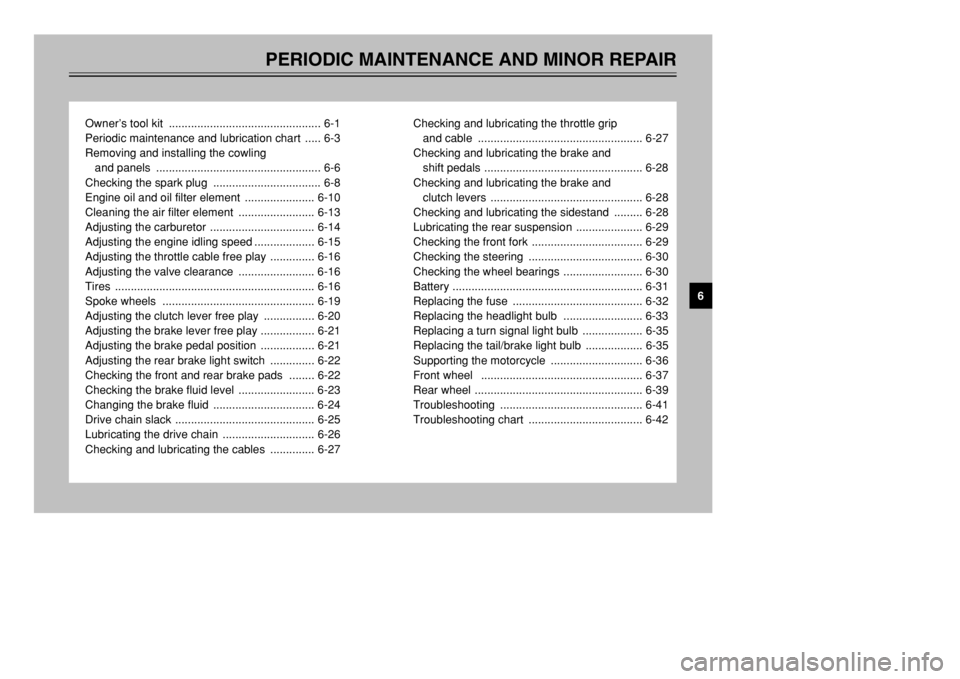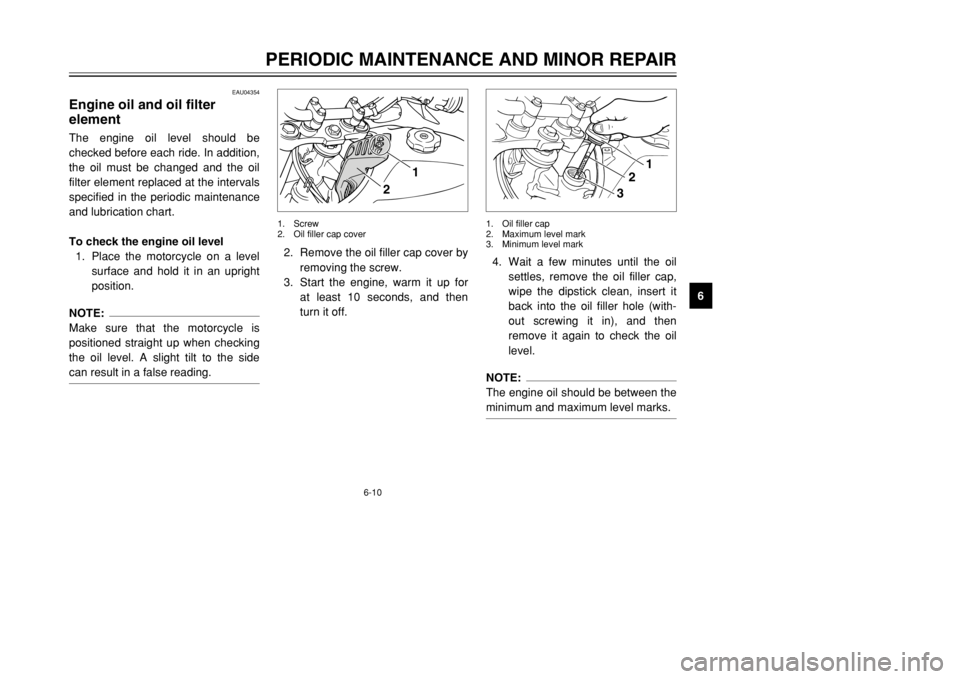check engine YAMAHA XT500E 2002 Owners Manual
[x] Cancel search | Manufacturer: YAMAHA, Model Year: 2002, Model line: XT500E, Model: YAMAHA XT500E 2002Pages: 100, PDF Size: 2.1 MB
Page 26 of 100

3-12
INSTRUMENT AND CONTROL FUNCTIONS
3
EW000044
wThe motorcycle must not be ridden
with the sidestand down, or if the
sidestand cannot be properly
moved up (or does not stay up),
otherwise the sidestand could con-
tact the ground and distract the
operator, resulting in a possible
loss of control. Yamaha’s ignition
circuit cut-off system has been
designed to assist the operator in
fulfilling the responsibility of rais-
ing the sidestand before starting
off. Therefore, check this system
regularly as described below and
have a Yamaha dealer repair it if it
does not function properly.
EAU03720
Ignition circuit cut-off
systemIgnition circuit cut-off systemThe ignition circuit cut-off system
(comprising the sidestand switch,
clutch switch and neutral switch) has
the following functions.
8It prevents starting when the
transmission is in gear and the
sidestand is up, but the clutch
lever is not pulled.
8It prevents starting when the
transmission is in gear and the
clutch lever is pulled, but the
sidestand is still down.
8It cuts the running engine when
the transmission is in gear and
the sidestand is moved down.
Periodically check the operation of
the ignition circuit cut-off system
according to the following procedure.
EW000045
wIf a malfunction is noted, have a
Yamaha dealer check the system
before riding.
4PT-E7 (English) 6/29/01 9:13 AM Page 25
Page 27 of 100

3-13
INSTRUMENT AND CONTROL FUNCTIONS
3
With the engine turned off:
1. Move the sidestand down.
2. Make sure that the engine stop switch is set to “
#”.
3. Turn the key to “ON”.
4. Shift the transmission into the neutral position.
5. Push the start switch.
Does the engine start?
The neutral switch may be defective.
The motorcycle should not be ridden until
checked by a Yamaha dealer.
With the engine still running:
6. Move the sidestand up.
7. Keep the clutch lever pulled.
8. Shift the transmission into gear.
9. Move the sidestand down.
Does the engine stall?After the engine has stalled:
10. Move the sidestand up.
11. Keep the clutch lever pulled.
12. Push the start switch.
Does the engine start?
The sidestand switch may be defective.
The motorcycle should not be ridden until
checked by a Yamaha dealer.The clutch switch may be defective.
The motorcycle should not be ridden until
checked by a Yamaha dealer.
NO
NOTE:This check is most reliable if performed with
a warmed-up engine.
YESYES NO
The system is OK. The motorcycle can be ridden.
YES NO
4PT-E7 (English) 6/29/01 9:13 AM Page 26
Page 29 of 100

4-1
EAU01114
PRE-OPERATION CHECKS
4The condition of a vehicle is the owner’s responsibility. Vital components can start to deteriorate quickly and unexpect-
edly, even if the vehicle remains unused (for example, as a result of exposure to the elements). Any damage, fluid leak-
age or loss of tire air pressure could have serious consequences. Therefore, it is very important, in addition to a thor-
ough visual inspection, to check the following points before each ride.
EAU03439
Pre-operation check list
Pre-operation check list
ITEM CHECKS PAGE
Fuel•Check fuel level in fuel tank.
•Refuel if necessary.
•Check fuel line for leakage.3-6–3-7
Engine oil•Check oil level in engine.
•If necessary, add recommended oil to specified level.
•Check vehicle for oil leakage.6-10–6-13
Front brake•Check operation.
•If soft or spongy, have Yamaha dealer bleed hydraulic system.
•Check lever free play.
•Adjust if necessary.
•Check fluid level in reservoir.
•If necessary, add recommended brake fluid to specified level.
•Check hydraulic system for leakage.3-5, 6-21–6-24
Rear brake•Check operation.
•If soft or spongy, have Yamaha dealer bleed hydraulic system.
•Check fluid level in reservoir.
•If necessary, add recommended brake fluid to specified level.
•Check hydraulic system for leakage.3-5, 6-21–6-24
4PT-E7 (English) 6/29/01 9:13 AM Page 28
Page 33 of 100

1. Turn the fuel cock lever to “ON”.
2. Turn the key to “ON” and make
sure that the engine stop switch
is set to “#”.
3. Shift the transmission into the
neutral position.NOTE:
When the transmission is in the neu-
tral position, the neutral indicator light
should be on, otherwise have a
Yamaha dealer check the electrical
circuit.4. Turn the starter (choke) on and
completely close the throttle.
(See page 3-9 for starter (choke)
operation.)
5. Start the engine by pushing the
start switch.
5-1
EAU00372
OPERATION AND IMPORTANT RIDING POINTS
5
EAU00373
w8Become thoroughly familiar
with all operating controls and
their functions before riding.
Consult a Yamaha dealer
regarding any control or func-
tion that you do not thorough-
ly understand.
8Never start the engine or oper-
ate it in a closed area for any
length of time. Exhaust fumes
are poisonous, and inhaling
them can cause loss of con-
sciousness and death within a
short time. Always make sure
that there is adequate ventila-
tion.
8Before starting out, make sure
that the sidestand is up. If the
sidestand is not raised com-
pletely, it could contact the
ground and distract the opera-
tor, resulting in a possible loss
of control.
EAU03515
Starting the engineStarting the engineIn order for the ignition circuit cut-off
system to enable starting, one of the
following conditions must be met:
8The transmission is in the neutral
position.
8The transmission is in gear with
the clutch lever pulled and the
sidestand up.
EW000054
w8Before starting the engine,
check the function of the igni-
tion circuit cut-off system
according to the procedure
described on page 3-13.
8Never ride with the sidestand
down.
4PT-E7 (English) 6/29/01 9:13 AM Page 32
Page 37 of 100

5-5
OPERATION AND IMPORTANT RIDING POINTS
5
EC000053
cC8Keep the engine speed out of
the tachometer red zone.
8If any engine trouble should
occur during the engine break-
in period, immediately have a
Yamaha dealer check the vehi-
cle.
EAU00457
ParkingParkingWhen parking, stop the engine,
remove the key from the main switch,
and then turn the fuel cock lever to
“OFF”.
EW000058
w8Since the engine and exhaust
system can become very hot,
park in a place where pedestri-
ans or children are not likely
to touch them.
8Do not park on a slope or on
soft ground, otherwise the
motorcycle may overturn.
4PT-E7 (English) 6/29/01 9:13 AM Page 36
Page 38 of 100

PERIODIC MAINTENANCE AND MINOR REPAIR
Owner’s tool kit ................................................ 6-1
Periodic maintenance and lubrication chart ..... 6-3
Removing and installing the cowling
and panels .................................................... 6-6
Checking the spark plug .................................. 6-8
Engine oil and oil filter element ...................... 6-10
Cleaning the air filter element ........................ 6-13
Adjusting the carburetor ................................. 6-14
Adjusting the engine idling speed ................... 6-15
Adjusting the throttle cable free play .............. 6-16
Adjusting the valve clearance ........................ 6-16
Tires ............................................................... 6-16
Spoke wheels ................................................ 6-19
Adjusting the clutch lever free play ................ 6-20
Adjusting the brake lever free play ................. 6-21
Adjusting the brake pedal position ................. 6-21
Adjusting the rear brake light switch .............. 6-22
Checking the front and rear brake pads ........ 6-22
Checking the brake fluid level ........................ 6-23
Changing the brake fluid ................................ 6-24
Drive chain slack ............................................ 6-25
Lubricating the drive chain ............................. 6-26
Checking and lubricating the cables .............. 6-27Checking and lubricating the throttle grip
and cable .................................................... 6-27
Checking and lubricating the brake and
shift pedals .................................................. 6-28
Checking and lubricating the brake and
clutch levers ................................................ 6-28
Checking and lubricating the sidestand ......... 6-28
Lubricating the rear suspension ..................... 6-29
Checking the front fork ................................... 6-29
Checking the steering .................................... 6-30
Checking the wheel bearings ......................... 6-30
Battery ............................................................ 6-31
Replacing the fuse ......................................... 6-32
Replacing the headlight bulb ......................... 6-33
Replacing a turn signal light bulb ................... 6-35
Replacing the tail/brake light bulb .................. 6-35
Supporting the motorcycle ............................. 6-36
Front wheel ................................................... 6-37
Rear wheel ..................................................... 6-39
Troubleshooting ............................................. 6-41
Troubleshooting chart .................................... 6-42
6
4PT-E7 (English) 6/29/01 9:13 AM Page 37
Page 43 of 100

6-5
PERIODIC MAINTENANCE AND MINOR REPAIR
6
EAU03884
NOTE:
8The air filter needs more frequent service if you are riding in unusually wet or dusty areas.
8Hydraulic brake service
9Regularly check and, if necessary, correct the brake fluid level.
9Every two years replace the internal components of the brake master cylinders and calipers, and change the
brake fluid.
9Replace the brake hoses every four years and if cracked or damaged.20
*Rear suspension relay
arm and connecting arm
pivoting points•Check operation.√√√√
•Lubricate with molybdenum disulfide grease.√√
21*Carburetor•Check starter (choke) operation.
•Adjust engine idling speed.√√√√√ √
22 Engine oil•Change.
•Check oil level and vehicle for oil leakage.√√√√√ √
23 Engine oil filter element•Replace.√√√
24*Front and rear brake
switches•Check operation.√√√√√ √
25 Moving parts and cables•Lubricate.√√√√ √
26*Lights, signals and
switches•Check operation.
•Adjust headlight beam.√√√√√ √ NO. ITEM CHECK OR MAINTENANCE JOBODOMETER READING (× 1,000 km)
ANNUAL
CHECK
1 10203040
4PT-E7 (English) 6/29/01 9:13 AM Page 42
Page 46 of 100

6-8
PERIODIC MAINTENANCE AND MINOR REPAIR
6
1
2
1. Panel B
2. Screw
2. Remove the spark plug as
shown, with the spark plug
wrench included in the owner’s
tool kit.
1
1. Spark plug wrench
EAU01833
Checking the spark plugSpark plug, checkingThe spark plug is an important
engine component, which is easy to
check. Since heat and deposits will
cause any spark plug to slowly erode,
the spark plug should be removed
and checked in accordance with the
periodic maintenance and lubrication
chart. In addition, the condition of the
spark plug can reveal the condition of
the engine.
To remove the spark plug
1. Remove the spark plug cap.
1
1. Spark plug cap
4PT-E7 (English) 6/29/01 9:13 AM Page 45
Page 47 of 100

6-9
PERIODIC MAINTENANCE AND MINOR REPAIR
6To check the spark plug
1. Check that the porcelain insula-
tor around the center electrode
of the spark plug is a medium-to-
light tan (the ideal color when the
motorcycle is ridden normally).
NOTE:
If the spark plug shows a distinctly
different color, the engine could be
defective. Do not attempt to diagnose
such problems yourself. Instead,
have a Yamaha dealer check the
motorcycle.2. Check the spark plug for elec-
trode erosion and excessive car-
bon or other deposits, and
replace it if necessary.3. Install the spark plug with the
spark plug wrench, and then
tighten it to the specified torque.
NOTE:
If a torque wrench is not available
when installing a spark plug, a good
estimate of the correct torque is 1/4-
1/2 turn past finger tight. However,
the spark plug should be tightened to
the specified torque as soon as pos-
sible.4. Install the spark plug cap. To install the spark plug
1. Measure the spark plug gap with
a wire thickness gauge and, if
necessary, adjust the gap to
specification.
2. Clean the surface of the spark
plug gasket and its mating sur-
face, and then wipe off any grime
from the spark plug threads.
a
a. Spark plug gap
Specified spark plug:
DPR8EA-9 or
DPR9EA-9 (NGK)
Spark plug gap:
0.8–0.9 mm
Tightening torque:
Spark plug:
17.5 Nm (1.75 m0kgf)
4PT-E7 (English) 6/29/01 9:13 AM Page 46
Page 48 of 100

6-10
PERIODIC MAINTENANCE AND MINOR REPAIR
6
EAU04354
Engine oil and oil filter
elementEngine oil and oil filter elementThe engine oil level should be
checked before each ride. In addition,
the oil must be changed and the oil
filter element replaced at the intervals
specified in the periodic maintenance
and lubrication chart.
To check the engine oil level
1. Place the motorcycle on a level
surface and hold it in an upright
position.NOTE:
Make sure that the motorcycle is
positioned straight up when checking
the oil level. A slight tilt to the side
can result in a false reading.
4. Wait a few minutes until the oil
settles, remove the oil filler cap,
wipe the dipstick clean, insert it
back into the oil filler hole (with-
out screwing it in), and then
remove it again to check the oil
level.NOTE:
The engine oil should be between the
minimum and maximum level marks.
1
2
3
1. Oil filler cap
2. Maximum level mark
3. Minimum level mark
2. Remove the oil filler cap cover by
removing the screw.
3. Start the engine, warm it up for
at least 10 seconds, and then
turn it off.
2
1
1. Screw
2. Oil filler cap cover
4PT-E7 (English) 6/29/01 9:13 AM Page 47